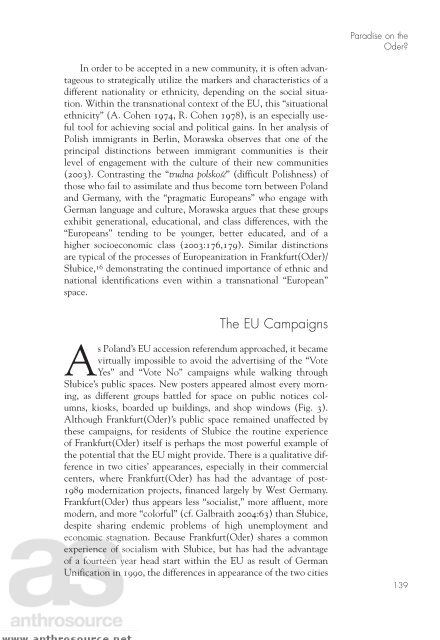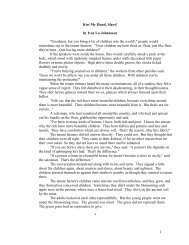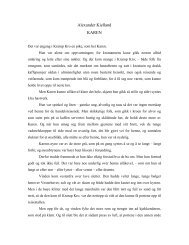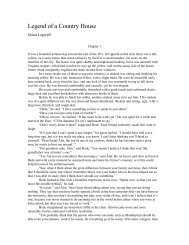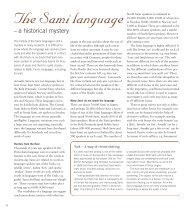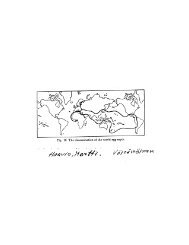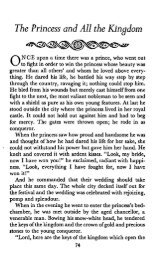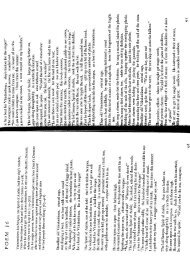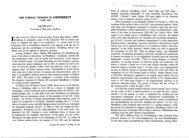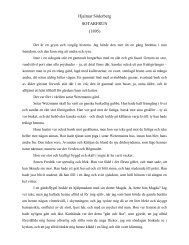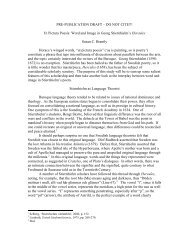A Paradise on the Oder? - Department of Scandinavian Studies
A Paradise on the Oder? - Department of Scandinavian Studies
A Paradise on the Oder? - Department of Scandinavian Studies
Create successful ePaper yourself
Turn your PDF publications into a flip-book with our unique Google optimized e-Paper software.
<str<strong>on</strong>g>Paradise</str<strong>on</strong>g> <strong>on</strong> <strong>the</strong><strong>Oder</strong>?In order to be accepted in a new community, it is <strong>of</strong>ten advantageousto strategically utilize <strong>the</strong> markers and characteristics <strong>of</strong> adifferent nati<strong>on</strong>ality or ethnicity, depending <strong>on</strong> <strong>the</strong> social situati<strong>on</strong>.Within <strong>the</strong> transnati<strong>on</strong>al c<strong>on</strong>text <strong>of</strong> <strong>the</strong> EU, this “situati<strong>on</strong>alethnicity” (A. Cohen 1974, R. Cohen 1978), is an especially usefultool for achieving social and political gains. In her analysis <strong>of</strong>Polish immigrants in Berlin, Morawska observes that <strong>on</strong>e <strong>of</strong> <strong>the</strong>principal distincti<strong>on</strong>s between immigrant communities is <strong>the</strong>irlevel <strong>of</strong> engagement with <strong>the</strong> culture <strong>of</strong> <strong>the</strong>ir new communities(2003). C<strong>on</strong>trasting <strong>the</strong> “trudna polskość” (difficult Polishness) <strong>of</strong>those who fail to assimilate and thus become torn between Polandand Germany, with <strong>the</strong> “pragmatic Europeans” who engage withGerman language and culture, Morawska argues that <strong>the</strong>se groupsexhibit generati<strong>on</strong>al, educati<strong>on</strong>al, and class differences, with <strong>the</strong>“Europeans” tending to be younger, better educated, and <strong>of</strong> ahigher socioec<strong>on</strong>omic class (2003:176,179). Similar distincti<strong>on</strong>sare typical <strong>of</strong> <strong>the</strong> processes <strong>of</strong> Europeanizati<strong>on</strong> in Frankfurt(<strong>Oder</strong>)/Słubice, 16 dem<strong>on</strong>strating <strong>the</strong> c<strong>on</strong>tinued importance <strong>of</strong> ethnic andnati<strong>on</strong>al identificati<strong>on</strong>s even within a transnati<strong>on</strong>al “European”space.The EU CampaignsAs Poland’s EU accessi<strong>on</strong> referendum approached, it becamevirtually impossible to avoid <strong>the</strong> advertising <strong>of</strong> <strong>the</strong> “VoteYes” and “Vote No” campaigns while walking throughSłubice’s public spaces. New posters appeared almost every morning,as different groups battled for space <strong>on</strong> public notices columns,kiosks, boarded up buildings, and shop windows (Fig. 3).Although Frankfurt(<strong>Oder</strong>)’s public space remained unaffected by<strong>the</strong>se campaigns, for residents <strong>of</strong> Słubice <strong>the</strong> routine experience<strong>of</strong> Frankfurt(<strong>Oder</strong>) itself is perhaps <strong>the</strong> most powerful example <strong>of</strong><strong>the</strong> potential that <strong>the</strong> EU might provide. There is a qualitative differencein two cities’ appearances, especially in <strong>the</strong>ir commercialcenters, where Frankfurt(<strong>Oder</strong>) has had <strong>the</strong> advantage <strong>of</strong> post-1989 modernizati<strong>on</strong> projects, financed largely by West Germany.Frankfurt(<strong>Oder</strong>) thus appears less “socialist,” more affluent, moremodern, and more “colorful” (cf. Galbraith 2004:63) than Słubice,despite sharing endemic problems <strong>of</strong> high unemployment andec<strong>on</strong>omic stagnati<strong>on</strong>. Because Frankfurt(<strong>Oder</strong>) shares a comm<strong>on</strong>experience <strong>of</strong> socialism with Słubice, but has had <strong>the</strong> advantage<strong>of</strong> a fourteen year head start within <strong>the</strong> EU as result <strong>of</strong> GermanUnificati<strong>on</strong> in 1990, <strong>the</strong> differences in appearance <strong>of</strong> <strong>the</strong> two cities139


